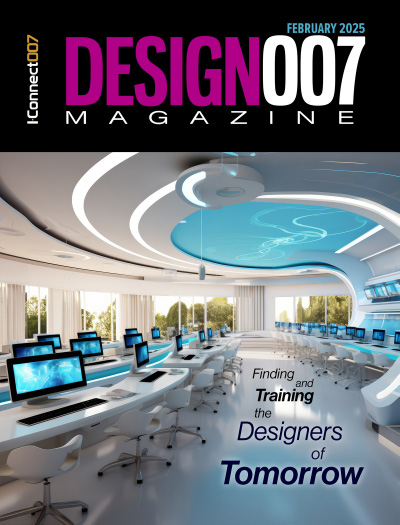-

- News
- Books
Featured Books
- design007 Magazine
Latest Issues
Current Issue
Designing Through the Noise
Our experts discuss the constantly evolving world of RF design, including the many tradeoffs, material considerations, and design tips and techniques that designers and design engineers need to know to succeed in this high-frequency realm.

Learning to Speak ‘Fab’
Our expert contributors clear up many of the miscommunication problems between PCB designers and their fab and assembly stakeholders. As you will see, a little extra planning early in the design cycle can go a long way toward maintaining open lines of communication with the fab and assembly folks.

Training New Designers
Where will we find the next generation of PCB designers and design engineers? Once we locate them, how will we train and educate them? What will PCB designers of the future need to master to deal with tomorrow’s technology?
- Articles
- Columns
Search Console
- Links
- Media kit
||| MENU - design007 Magazine
Albert Gaines: Design All Comes Down to Documentation
June 28, 2019 | Andy Shaughnessy, Design007 MagazineEstimated reading time: 2 minutes
During SMTA Atlanta, I spoke with Albert Gaines of HiGain Design. We discussed Albert’s belief that everything starts with design and that too many engineers and designers focus solely on the final board at the expense of the documentation, which is a designer’s most important product. Do you consider your documentation to be a critical product?
Andy Shaughnessy: Albert, you are the founder, chief cook, and bottle-washer for HiGain Design. A minute ago, we were talking about how everything in electronics manufacturing really starts with design. You had an interesting point about some things that designers and design engineers sometimes neglect to consider early in the cycle.
Albert Gaines: I’ve been doing board layout since ’81, and I came through the drafting side of it. Documentation was our product. I think most engineers today lose the concept of the fact that the final product is not the prototype. They finally have it working, but they think they’re through. But their product is documentation—the Gerber package, ODB++ package, testability, assembly drawings, and all of the firmware. That documentation and traceability of that documentation is their product—not what’s sitting in the test lab.
Shaughnessy: How did we get to this point? I’m sure that there are people who have been doing this for 30 years and have never looked at the documentation as their final product.
Gaines: A lot has changed over the years because we’ve had a shift to where more EEs are doing more board layout, and we don’t have documentation departments in companies. Everybody is running freelance in their own cubicles. Nobody is enforcing what the documentation has to be. Ultimately, you end up with a board shop or an assembly house with a big void, wondering, “Am I going to get this data, the IPC-356 netlist, or the bare testing of the board? Or am I going to get an ODB++ for pick-and-place? What am I going to get? Do we have to recreate it after the fact?”
Shaughnessy: We always joke about how the designers get blamed for everything, but this sounds like one of the things that designers need to be aware of; it’s more about the documentation than anything else.
Gaines: Yes. It would be very good for each designer to have a checklist beside their desk when they’re getting ready to finish a product, detailing what they need to do—not just generate Gerbers and NC drill files and send it over the fence to a board shop. When I output documentation, I have folders for assembly data, bare board data, and testing data, and everything goes in each particular folder. If something’s for assembly, you grab the whole folder, which has anything that may deal with the assembly world or test world or bare board. It’s good to have that reminder. Another resource is your magazines. You’ve published information on what average documentation looks like, but I wonder how many designers look at that list and say, “What is that?” They don’t even know what it is.
To read this entire interview, which appeared in the June 2019 issue of Design007 Magazine, click here.
Suggested Items
ZESTRON Announces New Reliability and Solutions Service for Risk Assessment & Mitigation of Electronic Assemblies
05/06/2025 | ZESTRONZESTRON, the leading global provider of high-precision cleaning products, services, and training solutions, is thrilled to introduce its new Reliability and Solutions (R&S) service.
PCB East Continues to Expand
05/06/2025 | Andy Shaughnessy, Design007 MagazineIt was a perfect week for a conference and trade show in metropolitan Boston, with high temperatures in the 70s. PCB East took place at the Boxboro Regency Hotel and Conference Center April 29–May 2, with the expo on April 30. PCB East has been expanding since its relaunch a few years ago, with conference and show attendance rising each year.
Green Circuits Expands Large-Format PCBA Capabilities with Installation of JUKI Primo Screen Printer
05/05/2025 | Green CircuitsGreen Circuits, a full-service Electronics Manufacturing Services (EMS) partner to leading OEMs, proudly announces the installation of the JUKI Primo Large-Format Screen Printer, expanding its capabilities to support printed circuit board assemblies (PCBAs) up to 33.5" x 24".
ASC Sunstone Circuits to Exhibit at PCB Detroit 2025
05/05/2025 | ASC SunstoneASC Sunstone Circuits will be exhibiting at the inaugural session of PCB Detroit to be held on June 2 and 3 on the campus of Wayne State University.
HyRel Technologies Celebrates Future Innovators: Intern Program Empowers the Next Generation of Engineers and Professionals
05/01/2025 | HyRelHyRel Technologies, a global provider of quick turn semiconductor modification solutions, is proud to spotlight its 7th class of interns in partnership with Peoria Unified School District, featuring three outstanding young women who are already making meaningful contributions to the company's innovative engineering and operations efforts.


